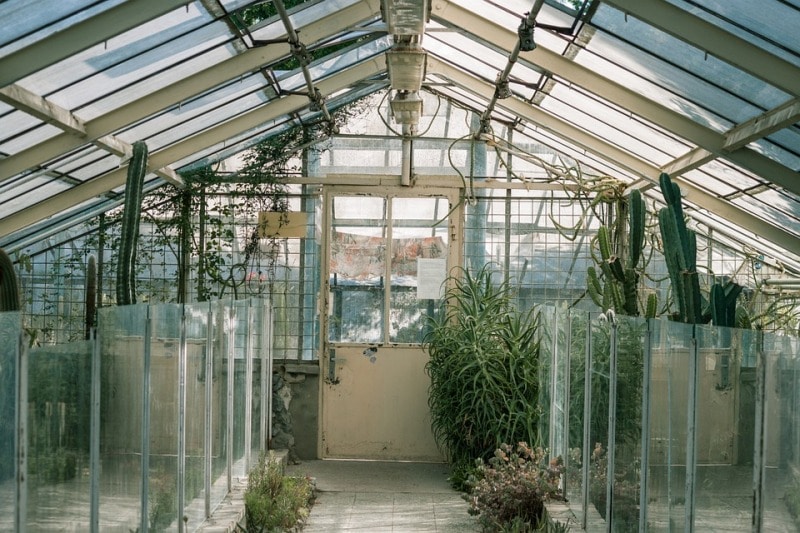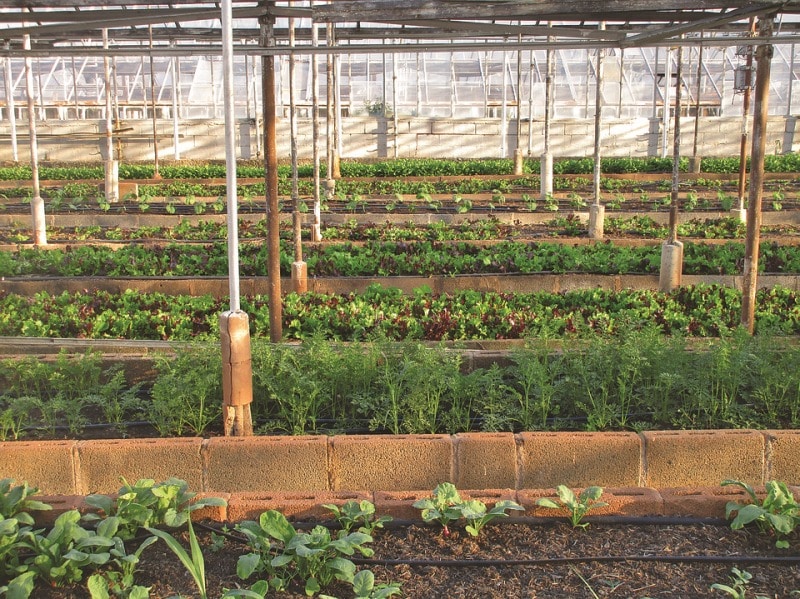Types of Greenhouse in India
Today, we discuss the topic of Types of Greenhouse in India and the materials used for the construction of the greenhouse. Greenhouse types and materials: What is a greenhouse? A greenhouse, more normally called a glasshouse in Europe, is an outdoor structure that is used to house plants. Often a simple frame covered by glass or by plastic, greenhouses works by insulating the environment, to a point, in order to extend the growing season.
A greenhouse is a framed enclosure or structure, covered with transparent material, that provides an opportunity for the control of all environmental factors that are capable of affecting crop yield and wide enough to facilitate the performance of cultural practices to aid crop growth and development.

Greenhouses can make an adequate growing temperature in summer and winter alike. They often are used for growing plants and trees that need strictly regulated climatic conditions. While these structures differ in terms of size and purpose, commercial greenhouses can be significantly larger and boast high-tech equipment designed to boost lighting, cooling, heating, and different types of screening installations. What is the purpose of having a greenhouse? The purpose of having a greenhouse is to shield crops from excess cold or heat and unwanted pests. A greenhouse makes it possible to grow definite types of crops year round, and fruits, vegetables, and flowers are what a greenhouse most normally grows.
All greenhouse buffer plants from freezing temperatures and contain clear walls and ceilings, allowing plants ideal growing conditions with maximum sunlight. Some greenhouses have built-in heating systems to protect plants during the winter, while others rely on the buildings themselves to maintain temperatures inside the greenhouse above freezing. In areas with hot summers, greenhouses might also work as shade houses, with drapes or screening to block the sunlight during peak hours for plants that can’t tolerate hours of direct sun. Now let us get into details of types of greenhouse in India.
Read: Growing Lettuce in Hydroponics.
The orientation of the greenhouse
The greenhouse for farming must be oriented in an east-west direction to maintain better sunlight level as compared to a north-south oriented one. This aids photosynthesis and excellent growth of crops, thus, allowing greenhouse farmers to have a good yield.
Maximum yield explains the greenhouse
Greenhouses are very beneficial to large-scale agricultural crops because the plants are sheltered from drastic weather changes like high winds, torrential rains, blizzards and dust storms, soil erosion, flash floods, and more. Crops grown in greenhouses are also protected from rodents and insects.
Types of greenhouses
What are the different types of greenhouses? The different types of greenhouses are explained below;
-
Wooden framed structures
In general, for the greenhouses with a span less than 6 m, wooden framed structures are used. Side posts and columns are constructed of wood without the use of a truss is commonly used as it is inexpensive and possesses the required strength. Timber locally obtainable, with good strength, durability and machinability can be used for the construction.
-
Pipe framed structures
Pipes are used for the construction of these greenhouses when the clear span is around 12m. In common, the side posts, columns, cross ties, and purlins are constructed using pipes. In this type, of greenhouses, the trusses are not used.
-
Polyhouse
The polyhouse is a generally used type of greenhouse across the globe. It is prepared of the frame (usually metal) of the desired size and covered with polyethylene film. Unlike glasshouse; polyethylene will be used as the glazing material. The polyhouse type greenhouse is not recommended at all in hilly regions because of poor temperature retention, low crop yield, and high installation cost.
-
Even-span greenhouse
An even-span greenhouse is a self-supporting commercial greenhouse and is the most general type of greenhouse. It is named an even-span as the distance from the ridge to the eave is equal on both sides.
-
Ridge-and-furrow greenhouse
Two or more even-span greenhouses connected at the eaves is known as a ridge-and-furrow greenhouse. It contains supports but no inner walls dividing the greenhouses. This allows for the making of horticultural crops requiring the same growing environments.
-
Contiguous greenhouse
Like the ridge-and-furrow type greenhouse, a contiguous greenhouse has two or more even-span greenhouses connected at the eaves. The difference is that a contiguous greenhouse contains inner walls separating the greenhouse which allows for the production of horticultural crops need different growing environments.
-
Lean-to greenhouse
A lean-to greenhouse is seldom used commercially and create attached to the south wall of a self-supporting structure. Lean-to greenhouses are normally used to start bulbs or seeds.
-
Truss framed structures
If the greenhouse span is greater than or equal to 15 meters, truss frames are used. Flat steel, tubular steel or angular iron is welded joints to form a truss encompassing rafters, chords, and struts. Struts are supporting members under compression and chords are maintaining members under tension. Angle iron purlins running during the length of the greenhouse are bolted to each truss. Columns are used in very wide truss frame houses of 21.3 m or more. Most of the glass houses are of truss frame type, as these frames are best suitable for pre-fabrication.
-
Glass greenhouses
Only glass type greenhouses with glass as the covering material existed prior to 1950. Glass as covering material has the benefit of greater interior light intensity. These greenhouses have a higher air infiltration rate, which leads to lower interior humidity and improved disease prevention.
-
Plastic film greenhouses
Flexible plastic films, including polyethylene, polyester, and polyvinyl chloride are used as covering material in this kind of greenhouses. Plastics as covering material for greenhouses have become popular, as they are cheap and the cost of heating is less when compared to glass type greenhouses. The major disadvantage of plastic films is its short life. For example, the best quality ultraviolet (UV) stabilized film can last for 4 years only. Quonset design, as well as gutter-connected design, is appropriate for using this covering material.
-
Rigid panel greenhouses
Fiberglass-reinforced plastic and polycarbonate rigid panels are employed as the covering material in the Quonset variety frames or ridge and furrow type frame. Very high-grade panels have a long life even up to 20 years. The major disadvantage is that these panels tend to collect dust as well as to harbor algae, which results in a darkening of the panels and subsequent reduction in the light transmission. There is an important danger of fire hazard.
-
Net house
The net house is a simple kind of greenhouse; here, a net is used as the glazing material, thereby, reducing the adverse effects of the sun and heavy rain.
Materials used in a designing of greenhouse:

Read: How to Grow Sweet Corn at Home.
The different materials used in building a greenhouse are;
Technically, a greenhouse is a frame-like structure generally made of metals of suitable size. The varying material is the glazing material or film, used in covering the greenhouse. The cost, climatic and environmental conditions generally determine the types of gazing material or film used in the greenhouse. Mostly, there are four (4) materials used in covering the greenhouse.
Glass
The glass is universally the major preferred covering material for greenhouses because of its light transmissivity and better temperature retention. Though, the high cost of installation, fervent damage, and poor maintenance are the liming factors in the use of glass as a film in greenhouses.
Fiberglass
Fiberglass Reinforced Plastic (FRP) is another good choice for your greenhouse. FRP scatters sunlight, providing good diffusion and light transmission throughout the greenhouse, and can last up to 10 years. However, UV rays break down the fiberglass over time, creating the cover brittle. To maintain the strength of fiberglass panels, you need to apply a new UV coating every few years.
Polyethylene
Remember, glass is the main preferred but polyethylene is the widely used greenhouse film or covering material across the globe. Only a UV-stabilized polyethylene sheet is suggested because Non-UV polyethylene will break down after 3 to 5months due to photochemical reactions.
Polyethylene film is tough, flexible and inexpensive. It can withstand as low as -50°C but melts at a temperature between 80-90°C; temperature above 60°C will make it lose much of its strength and can stretch significantly.
Polycarbonate greenhouse panels
Polycarbonate is a strong and light-weight material. Panels prepared for outdoor use have UV treatments that help prevent yellowing and deterioration from sunlight and are guaranteed for about 10 years.
Read: How to Grow Louki on the Terrace.
Maintenance of climatic factors in the greenhouse
There are certain climatic factors need to know and maintain before construction of a greenhouse. They are:
Sunlight
Sunlight is necessary for crop growth and development. It is the main source of energy used by plants and it is essential for photosynthesis. A greenhouse must be constructed such that it receives sunlight for maximum hours.
In hilly regions, the greenhouse must face the southeast direction and it should not be located under shade. In the tropics, temperature retention must be reduced by choosing a less-sunny site.
Temperature
The rate of reactions is always favored by high temperature; however, the temperature through the night hours can drop to below 0°C and heat obtained during the day are not conserved. To keep an adequate temperature in a greenhouse, use the below practices.
- Keep a container filled with water inside the greenhouse
- Place black-colored stones in the greenhouse
Relative Humidity
This is the amount of water there in the atmosphere. The minimum necessity of relative humidity to enhance the normal physiological function of the plants is 50 percent. In the greenhouse, adequate water application and restricted air circulation, help keep the relative humidity of the greenhouse.
Soil
The soil is the main popular medium of plant growth. The greatest choice of soil in the greenhouse is the sandy loam soil enriched with decomposed farmyard manure, compost or biofertilizer to aid its productivity.
The soil in the greenhouse needs to be treated during soil sterilization or soil solarization to prevent pathogen and pests within the soil.
Carbon-dioxide
Plants need carbon-dioxide for the procedure of photosynthesis to make organic matter. In the cold, arid regions, carbon-dioxide concentration is below normal and within the greenhouse; it will drop further as an effect of consumption of the plants. The supplementary function of carbon-dioxide will boost plant productivity in the greenhouse.
In a hilly environment, suitable air circulation is a better means of controlling the undesirable lowering of carbon-dioxide. A strongly closed greenhouse helps to conserve carbon-dioxide in the night.
That’s all folks types of greenhouse in India.
Read: Cinnamon Leaf Oil Extraction Process.